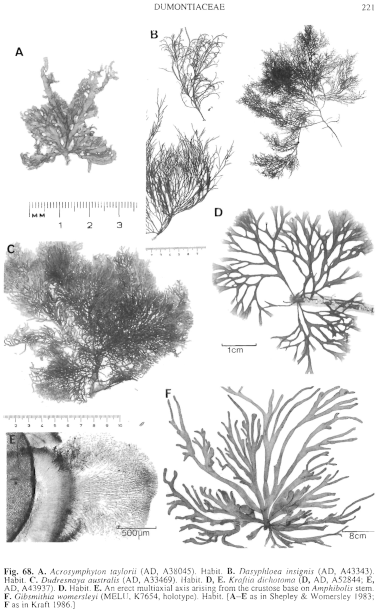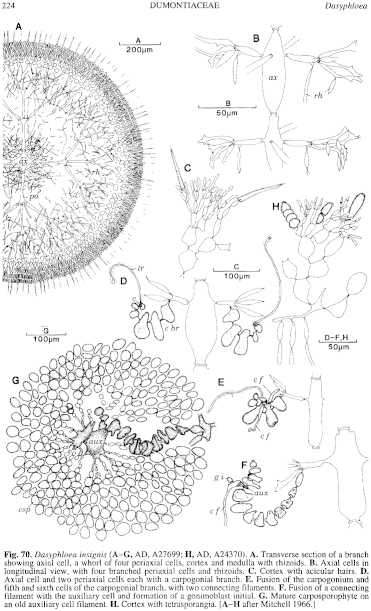|
|
|
|
|
|||||||||||
|
Electronic Flora of South Australia Species Fact Sheet
Phylum Rhodophyta – Class Florideophyceae – Order Gigartinales – Family Dumontiaceae
Selected citations: Mitchell 1966: 210, pls 22–26. Shepley & Womersley 1983: 206, fig. 1C, D.
Synonyms
D. tasmanica Hooker & Harvey 1847: 406. Harvey 1859a: pl. 115; 1859b: 320.
Chylocladia multiramea Sonder 1853: 681.
Dasyphloea gigartinoides Sonder 1881: 105 (nomen nudum).
Thallus (Fig. 68B) erect, 5–20 (–40) cm high, with one or more axes radially and irregularly branched to several orders, branches tapering from base to apices. Holdfast discoid, 1–3 mm across; epilithic or epiphytic on Amphibolis. Structure (Fig. 70A, B) uniaxial, with whorls of 4 periaxial cells each producing several orders of 3–4 elongate cells, then 2–3 layers of ovoid cells and 4–5 layers of small cells forming a compact cortex with the outermost forming a tomentum of acicular, thick-walled, hyaline hairs (Fig. 70A, C) as well as normal floridean hairs; periaxial and elongate medullary cells producing descending rhizoids (Fig. 70B), with the mature thallus differentiated into a filamentous medulla and pseudoparenchymatous cortex.
Reproduction: Sexual thalli dioecious, male gametophyte with fewer acicular hairs. Carpogonial and auxiliary cell branches scattered throughout the young thallus, borne on the lower side of periaxial and inner medullary cells. Carpogonial branches (Fig. 70D) 5–6 cells long, reflexed with the carpogonium lying adjacent to cell 4, and cells 4, 5 and 6 larger than cells 2 and 3. Following fertilization (Fig. 70E), the carpogonium fuses with cell 4 (sometimes with cells 5 and 6) and the fusion cell produces several connecting filaments each with a basal pit-connection. Auxiliary cell branches (Fig. 70F) 12–15 cells long, curved, with the auxiliary cell usually 4 (3–5) cells from the apex and slightly smaller and less densely staining than other cells. Carposporophytes (Fig. 70G) prominent, swelling and distorting the thallus, with radiating gonimoblast filaments each cell of which becomes a carposporangium, and developing a comparatively large basal fusion cell. Spermatangia cut off from the outermost cortical cells in groups of 2–3, elongate.
Tetrasporophytes more robust and less branched than gametophytes, producing large, zonately divided tetrasporangia (Fig. 70H) from inner cortical cells.
Type probably from Tasmania (rather than Akaroa, N.Z. - see Mitchell 1966, p.210); in Herb. Montagne, PC.
Selected specimens: Wanna, S. Aust., drift (Womersley, 19.ii.1959; AD, A22373). Aldinga, S. Aust., drift on Amphibolis (Womersley, 23.iv.1973; AD, A43343 -"Marine Algae of southern Australia" No. 154). Stanley Beach, S coast Kangaroo I., S. Aust., drift (Womersley, 27.i.1956; AD, A20380). Port Elliot, S. Aust., drift (Womersley, 17.v.1960; AD, A24370). Walkerville, Vic., drift (Sinkora A2165, 7.iii.1975; AD, A48554). Dover, Tas., drift (Wollaston & Mitchell, 27.ii.1964; AD, A27699).
Distribution: Wanna, Eyre Pen., S. Aust., to Walkerville, Vic., and around Tasmania; sublittoral, 2–17 m deep.
References:
HARVEY, W.H. (1859a). Phycologia Australica. Vol. 2, Plates 61–120. (Reeve: London.)
HARVEY, W.H. (1859b). Algae. In Hooker, J.D., The Botany of the Antarctic Voyage. Flora Tasmaniae. Vol. II, pp. 282–320.
HOOKER, J.D. & HARVEY, W.H. (1847). Algae Tasmanicae. Lond. J. Bot. 6, 397–417.
MITCHELL, E.A. (1966). The southern Australian genera of the Dumontiaceae (Rhodophyta). Nova Hedwigia 11, 209–220, Plates 22–26:2.
MONTAGNE, C. (1842). Prodromus Generum Specierumque Phycearum Novarum in Itinere ad Polum Antarcticum. (Paris.)
MONTAGNE, C. (1845). Voyage au Pôle Sud et dans l'Océanie sur les Corvettes l'Astrolabe et la Mee. Botanique, T I. Plantes cellulaires. (Plates 1–20 dated 1852.)
SHEPLEY, E.A. & WOMERSLEY, H.B.S. (1983). The Dumontiaceae (Cryptonemiales: Rhodophyta) of southern Australia. Trans. R. Soc. S. Aust. 107, 201–217.
SONDER, O.W. (1853). Plantae Muellerianae. Algae. Linnaea 25, 657–709.
SONDER, O.W. (1881). In Mueller, F., Fragmenta Phytographiae Australiae. Supplementum ad volumen undecinum: Algae Australianae hactenus cognitae, pp. 1–42, 105–107. (Melbourne.)
The Marine Benthic Flora of Southern Australia Part IIIA complete list of references.
Publication:
Womersley, H.B.S. (14 January, 1994)
The Marine Benthic Flora of Southern Australia
Rhodophyta. Part IIIA, Bangiophyceae and Florideophyceae (to Gigartinales)
Reproduced with permission from The Marine Benthic Flora of Southern Australia Part IIIA 1994, by H.B.S. Womersley. Australian Biological Resources Study, Canberra. Copyright Commonwealth of Australia.
Illustrations in Womersley Part IIIA, 1994: FIGS 68B, 70.

Figure 68 enlarge
Fig. 68. A. Acrosymphyton taylorii (AD, A38045). Habit. B. Dasyphloea insignis (AD, A43343). Habit. C. Dudresnaya australis (AD, A33469). Habit. D, E. Kraftia dichotoma (D, AD, A52844; E, AD, A43937). D. Habit. E. An erect multiaxial axis arising from the crustose base on Amphibolis stem. F. Gibsmithia womersleyi (MELU, K7654, holotype). Habit. [A–E as in Shepley & Womersley 1983; F as in Kraft 1986.]

Figure 70 enlarge
Fig. 70. Dasyphloea insignis (A–G, AD, A27699; H, AD, A24370). A. Transverse section of a branch showing axial cell, a whorl of four periaxial cells, cortex and medulla with rhizoids. B. Axial cells in longitudinal view, with four branched periaxial cells and rhizoids. C. Cortex with acicular hairs. D. Axial cell and two periaxial cells each with a carpogonial branch. E. Fusion of the carpogonium and fifth and sixth cells of the carpogonial branch, with two connecting filaments. F. Fusion of a connecting filament with the auxiliary cell and formation of a gonimoblast initial. G. Mature carposporophyte on an old auxiliary cell filament. H. Cortex with tetrasporangia. [A–H after Mitchell 1966.]

|
Email Contact: State Herbarium of South Australia |

|